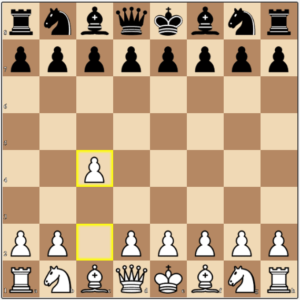The English Opening is a strategic and flexible chess opening that starts with the move 1.c4. It allows players to control the center, prepare for strong counter-attacks, and create solid positions. Named after the 19th-century English master Howard Staunton, the English Opening has become one of the most popular choices for both beginners and grandmasters alike. In this blog, we’ll explore the key concepts, variations, and strategies of the English Opening, answer frequently asked questions, and showcase a few famous games that highlight its potential.
What is the English Opening?
The English Opening begins with 1.c4, aiming to control the d5 square without immediately occupying the center. Unlike other openings that focus on moving pawns to the center early on, the English Opening allows White to develop pieces flexibly and adapt to Black’s responses. This opening can transpose into various structures, including those found in the King’s Indian, Sicilian Defense, and even some Queen’s Pawn openings.
Rather than occupying the centre with your pawns (as with 1.e4 and 1.d4 openings) a 1.c4 opening is a flank attack in which White will look to initially contest this key ground from further afield. Before any other moves are made, the move 1.c4 achieves the following for White:
- Control of the d5 Square: The English Opening is all about controlling the central d5 square without immediately occupying it. White often prepares moves like d4 to strengthen their grip over the center.
- It kicks off a flank attack and grabs space on the queenside.
- It rules out several of Black’s most typical forcing lines (after 1.e4 or 1.d4).

Why Do Players Choose the English Opening?
Players choose the English Opening because of its flexibility, control over key squares, and the ability to play both offensively and defensively. The opening allows players to avoid heavily analyzed lines and shift the game into unique positions. It’s also a great choice for players looking to keep the game in quieter or more positional realms while waiting for the right moment to strike.
Key Variations in the English Opening
- Symmetrical Variation (1.c4 c5): In this variation, Black mirrors White’s moves, leading to symmetrical pawn structures. This line often leads to slow, strategic play and can develop into various pawn structures depending on the subsequent moves.
- Reversed Sicilian (1.c4 e5): The Reversed Sicilian is one of the most popular responses to the English Opening. Black aims to adopt a setup similar to the Sicilian Defense with an extra tempo for White, often leading to a complex and dynamic game.
- Botvinnik System (1.c4 g6 followed by d3 and e4): Named after Mikhail Botvinnik, this system involves White building a strong pawn center while maintaining flexibility with piece development. This system is often employed for strategic, slow buildup.
- Four Knights Variation (1.c4 e5 2.Nc3 Nc6 3.Nf3 Nf6): This setup is known for leading to balanced yet rich positions. The Four Knights Variation allows both players to develop naturally and can lead to either quiet or open positions depending on how they choose to proceed.
Famous Games Using the English Opening
- Anatoly Karpov vs. Viktor Korchnoi (World Championship 1978) – This game is a masterclass in controlling the board and leveraging the English Opening’s flexible pawn structure. Karpov used the English Opening to outmaneuver Korchnoi with precise positional play, ultimately winning in a memorable endgame.
- Garry Kasparov vs. Nigel Short (1993 PCA World Championship) – Kasparov used the English Opening with great success, showcasing how it can be adapted to aggressive, attacking play. This game demonstrates the Reversed Sicilian Variation and how it can create sharp positions with winning opportunities.
- Magnus Carlsen vs. Viswanathan Anand (World Championship 2013) – Carlsen utilized the English Opening as a way to gain a positional edge over Anand. This game highlights how the English Opening can lead to a slow buildup, where even slight inaccuracies by the opponent can be exploited.
FAQs About the English Opening
1. Is the English Opening suitable for beginners?
Yes, the English Opening is suitable for beginners as it provides solid structure and strategic ideas without requiring extensive theoretical knowledge. Beginners can learn fundamental chess principles like controlling the center, developing pieces, and preparing for counter-attacks.
2. What are the main ideas behind the English Opening?
The English Opening aims to control the center indirectly, particularly focusing on the d5 square, while giving White flexibility in pawn structure and piece placement. It can transpose into various other openings, allowing players to adapt to different setups based on Black’s moves.
3. Why is it called the English Opening?
The opening is named after Howard Staunton, an English chess player who popularized it in the mid-19th century. Staunton’s games contributed to its recognition as a distinct opening.
4. What are the advantages of the English Opening?
The main advantages include flexibility, control of the center, and the ability to steer the game into various positions. It avoids many of the heavily analyzed lines of other openings and allows White to dictate the pace and style of the game.
5. Are there any disadvantages to the English Opening?
One disadvantage is that it can sometimes lead to passive or slow positions if White is not careful. Additionally, players who prefer sharp, tactical play may find the English Opening less exciting due to its strategic nature.
6. How does the English Opening compare to 1.e4 or 1.d4?
While 1.e4 and 1.d4 are direct ways of controlling the center, 1.c4 focuses on controlling the d5 square indirectly. The English Opening often leads to more closed or semi-closed positions, allowing for maneuvering and strategic play rather than immediate open-center tactics.
7. What are common traps in the English Opening?
A common trap involves an early push of the d4 pawn when White hasn’t adequately prepared the center, leading to weaknesses that Black can exploit. Another trap can occur when White overextends with pawn moves, allowing Black to counter-attack.
8. How should Black respond to the English Opening?
Common responses include 1…e5 (Reversed Sicilian), 1…c5 (Symmetrical Variation), and 1…Nf6. Black has various setups to choose from based on their preferred style, whether that’s symmetrical, counter-attacking, or defensive.
9. Can the English Opening lead to aggressive positions?
Yes, especially if White opts for the Reversed Sicilian or an early kingside fianchetto. Although the English Opening is generally more positional, it can become aggressive with certain setups.
10. Which famous players use the English Opening?
Many top players, including Magnus Carlsen, Garry Kasparov, and Anatoly Karpov, have used the English Opening with great success in their games, showcasing its versatility and strength.
Conclusion
The English Opening is a versatile and strategic choice that offers players flexibility, control, and the opportunity to adapt to various positions. Whether you’re a beginner or a seasoned player, the English Opening can add a unique dimension to your game. It combines slow, methodical play with the potential for sharp counter-attacks, making it an excellent opening to explore and master. With famous players like Kasparov and Carlsen using it to great effect, the English Opening remains a powerful weapon in the arsenal of chess players worldwide.

